Western Pond Turtles – How to Have One and Take Proper Care of Your Beloved Turtle
Let’s face it; we all wanted a pet turtle at some point in our lives. But given the various turtles in nature and captivity, it’s tough to choose which one to keep.
If you’re still not over that wish and want a turtle for your pet collection, we are here to provide you with the information you need to keep one species of turtle as your pet; the western pond turtle.
These turtles are generally found on North America’s western coasts and Mexico. Some have also been found in Washington and the Baja area of California.
Some basic information about the western pond turtle you need to know:
Contents
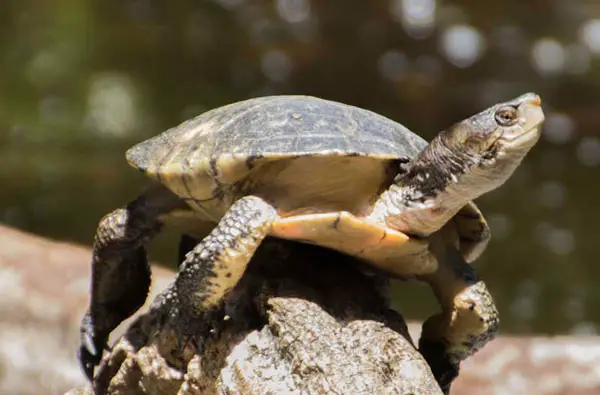
| Scientific Name | Actinemys marmorata |
| Common Name | Pacific pond turtle |
| Adult Size | 4-6 inches |
| Max Size: | 6-8 inches |
| Lifespan: | In the wild: 50 years In captivity: 40-80 years |
| Diet | Omnivorous |
| Range | North America, West Coast; from Baja, Mexico to Washington state |
| Behavior | Mostly Dinural, meaning they hunt for food during the day. But can change during hot weather and shift to night |
| Clutch Size: | 1-13 eggs |
| Legal to Keep in the USA: | Protected in some regions. You should check with your local state before acquiring one |
| Extinction status: | Vulnerable. Extinct in Canada |
Are Western Pond Turtles easy to take care of?
So, you have decided to have a western pond turtle as your turtle of choice. Now let us talk about the care of western pond turtles. Firstly, as pets, Western pond turtles require specialized care because of their habitat.
Also, since these turtles can live from 40-80 years in captivity, a western pond turtle needs someone adept at keeping reptiles to have a quality life.
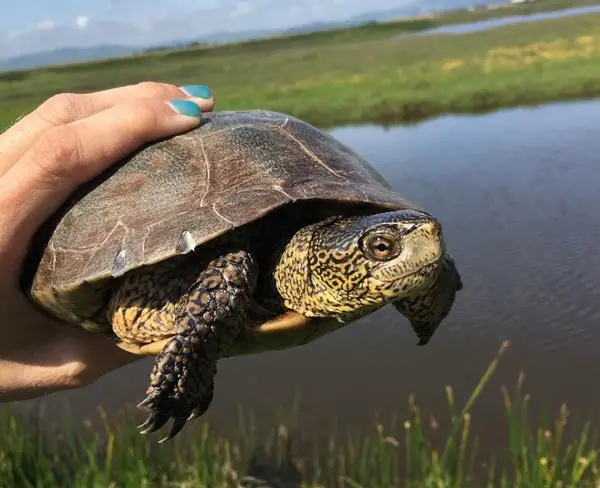
As such, they are not suitable as pets for kids. To keep a western pond turtle, you should make a western pond turtle care sheet. This care sheet should have the following:
- Food chart
- Feeding time
- Basking time
- Habitat requirements
- Possible diseases the western pond turtle are susceptible to etc.
How to take care of a Western Pond Turtle?
Let’s begin with a reminder that western pond turtles, like other reptiles, are long-lived. So if you decide to keep one, remember that they are a lifelong commitment and companion.
Let’s begin with the first step of keeping a western pond turtle; creating a habitat. Remember that these turtles live in ponds, marshes, and swamps. So you will have to create a habitat that resembles at least one of them. Start by creating an enclosure surrounded by land area and plant vegetation around the area to create a basking and hiding spot for the turtle(s).
Furthermore, create a pond or a pond-like structure for the turtle to swim in and feed. Create a 2-3feet fence around the enclosure so the turtle cannot escape the enclosure.
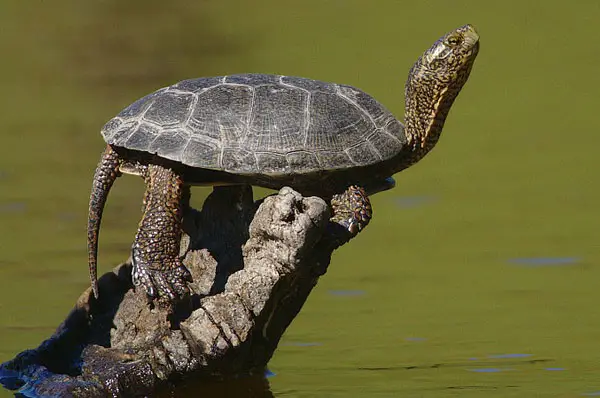
Don’t worry; you won’t need a more giant fence since turtles can’t climb. Create resting places for your turtle(s) by adding pieces of bark and word in and around the pond.
Turtles need to bask in the sun at least once a day and have floating materials like driftwood, Styrofoam, rocks, etc. Remember that the pond water needs to be changed at least once a week.
Take one bucket of water and change it with another bucket of dechlorinated water. You can easily dechlorinate water by keeping it outside for 24 hours or buying an aquarium dechlorinator from a pet store.
Now, let’s move on to feeding the turtles. Given the age and size of your turtle, you can feed them the following:
| Type | Adult | Juvenile |
| Food | Algae, aquatic plants, insects, tadpoles, mealworms, earthworms, feeder fish, and crickets mixed with vitamin and calcium supplements | Algae, aquatic plants, insects, tadpoles, mealworms, earthworms, feeder fish, and crickets mixed with vitamin and calcium supplements |
| Feeding time | Two-Four times a week | A Hearty amount every day |
Remember that these turtles are omnivores and eat plants and other animals. So a proper diet should consist of the foods above.
Furthermore, if you plan on keeping two different sexes of turtle and breeding them, you will also need to create a where the female can lay her eggs once she is ready to reproduce.
The female western pond turtle reaches sexual maturity at around 10-15 years, while males reach sexual maturity at around 8-12 years, so be ready to put in a long-term investment.
Once the turtles are sexually mature, they mate in the spring or fall season. While nesting occurs around May or June. For the nesting period, you’ll need to provide your female western pond turtle with a place with dry soil or sand and small vegetation.
Once your female western pond turtle creates a space for laying her eggs, she will disperse a clutch of about 3-13 eggs. The incubation of these eggs can happen from anywhere between 90-130 days.
Then when the eggs hatch, the hatchlings are born independent and on their own, so you’ll need to keep an eye on them to ensure they grow up safe and healthy.
Can you keep Western Pond Turtle as a pet?
Now, coming to the big question and its answer, can you keep a western pond turtle as a pet? Well, the answer is; it depends on the state you live in.
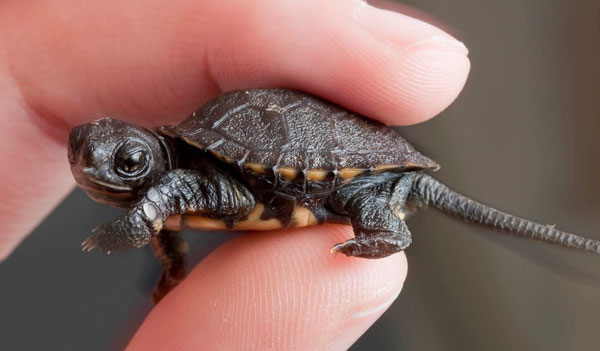
As mentioned before, these turtles are considered vulnerable species and, as such, are illegal to keep in some states in the USA. So, if you plan on keeping one, it is advised to check with your local state before getting western pond turtles as pets.
What does a Western Pond Turtle need in a tank?
Okay, so you have talked to your local state and learned that keeping a western pond turtle as a pet in your area is legal. But what if you lack a backyard or open space to keep the turtles? Don’t worry! We will guide you through how you can keep these turtles in a tank and still give them a healthy, happy, and quality-full life.
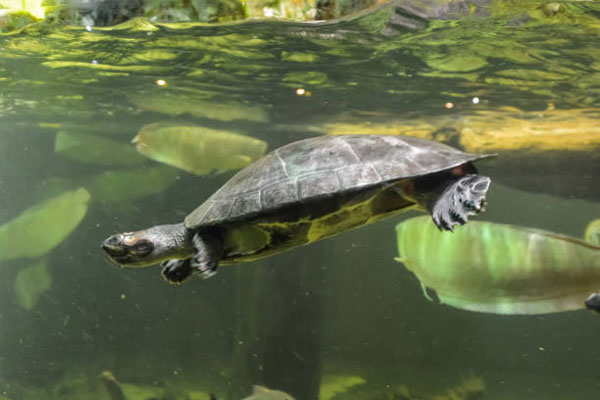
First, your tank should not be any smaller than 20 gallons. It should also imitate the natural habitat of the turtles. Read the following chart for more information on how you can create the perfect habitat for your western pond turtle inside a tank:
| Tank Size | Temperature | Light | Cleaning | Equipment’s |
| <20 gallons | 90°F to 95°F | fluorescent UV bulbs | Regularly | Hydrosponge, under-gravel, powerhead |
Let us go a little more through the information above and know why these are required. Firstly, because western pond turtles live in ponds and marshes naturally, their habitat in captivity should be large enough to ensure you have enough space for a full-grown western pond turtle. This is why you need a tank that is at least, if not larger than, 20 gallons.
Moreover, since turtles bask, the temperature in captivity should be optimal to give them a prospering environment. We will touch on basking and how you can provide the best basking environment for your turtle later in the article.
Moving on, the need for fluorescent UV bulbs in a tank is a must if you cannot let your turtles out in the open as they get vitamin D3 by using UV radiation.
Now, when it comes to cleaning, your turtle will help you with this by eating the algae formed in your tank. But still, you should regularly clean your tank. One of the musts of keeping your tank clean is replacing some water with new, dechlorinated water once a week.
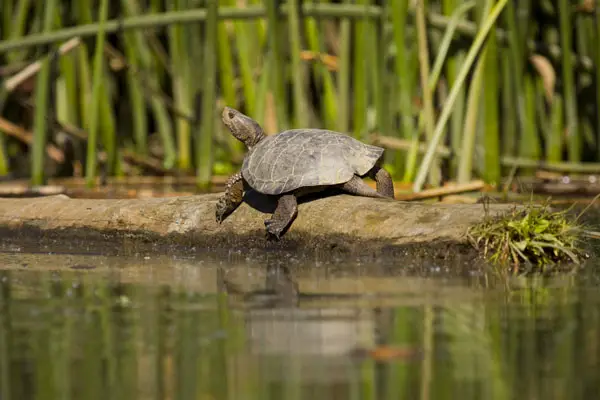
This is also where the equipment’s come into play; hydro sponge, under-gravel, and powerhead filters help to keep the water in your tank clean by collecting debris, uneaten food, and the feces of your turtle. By applying all the information above, you can create the perfect tank setup and provide what your western pond turtle needs.
Let’s talk about basking!
We all know that most reptiles are cold-blooded, which means they need sunlight to raise their body temperature. This applies to turtles too, and as such, you need to provide the perfect basking area for the proper care of western pond turtles.
Whether you keep them in a pond or a tank, your western pond turtle needs a basking area. Adding driftwood, floating barks, rocks, and decorative aquarium-friendly Styrofoam can provide a basking area.
With a proper basking area and enough basking time, you will have thriving western pond turtles as pets.
Conclusion
Turtles are fun pets to have. With their shyness and various antics, a pet turtle could turn a gloomy day into fun once you have bonded with it. Due to western pond turtles being shy and solitary, it is advised to keep only one until they’re ready to breed. Give proper love and care to your turtle, and watch it become a lifelong friend and companion. We hope reading this article will give you all the knowledge you need to keep western pond turtles as pets.
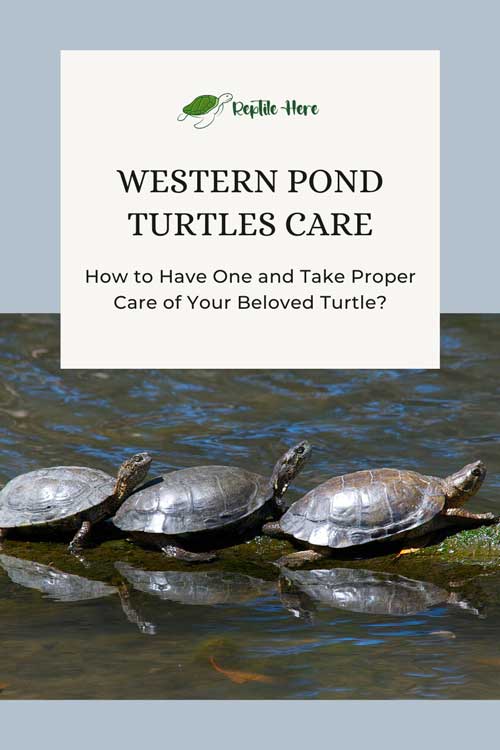

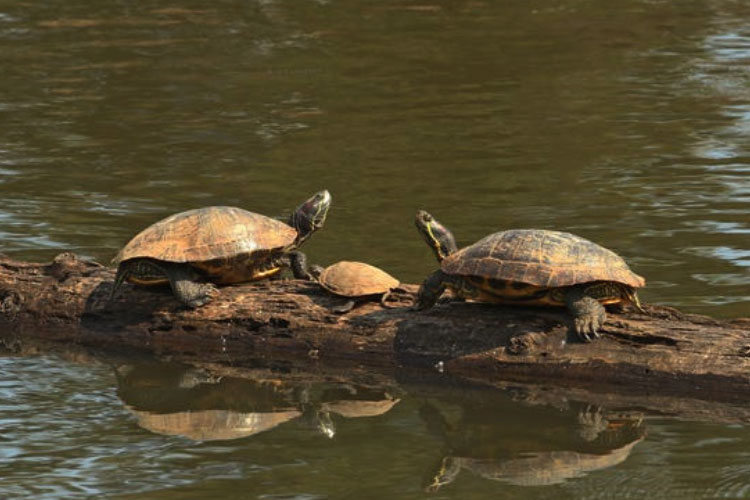
I don’t see anyone that sells these. I am guessing its due to the combination of their scarcity and protection. Any ideas?